Roman Dial. Does he need introduction? Maybe.
Packrafter extraordinaire. Roman is in a League of his own - he wrote the de-facto book on it . He travels the world is a Professor of Biology & Mathematics, and is mates with Andrew Skurka. I hope some day his travels bring him to Finland, and that we will have an epic trip like the one he had last year. Make sure to read his blog after you're done with this wonderful trip report.
. He travels the world is a Professor of Biology & Mathematics, and is mates with Andrew Skurka. I hope some day his travels bring him to Finland, and that we will have an epic trip like the one he had last year. Make sure to read his blog after you're done with this wonderful trip report.
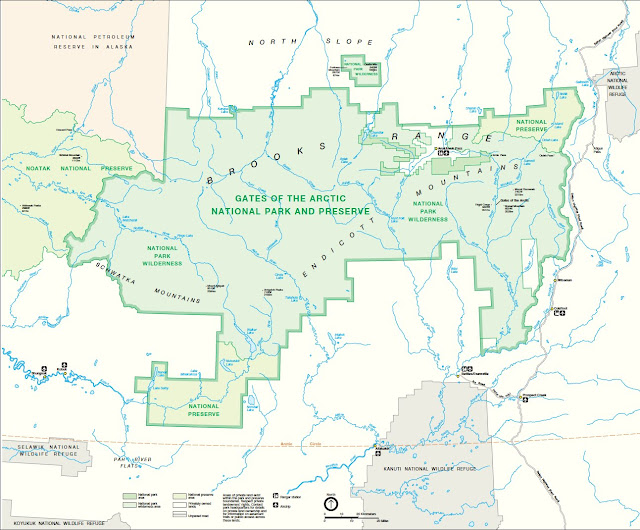
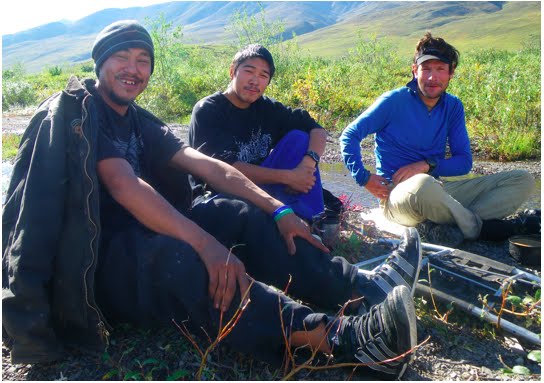
August 15
Mi 4209 Anaktuvuk Pass. Overnight stop an opportunity to do laundry,
shave, call parents. Package pickup in AM, then 12-day push to Ambler.”
We were a Party Train on an errand, a rather long errand, at the tail end of an Epic:
The Talent, the Photographer, the Hack and the Lackey pulled up short in Anaktuvuk Pass, a Nunamiut village of Innupiaq in the Brooks Range.
Three days walk from the nearest highway and the Alaska Pipeline, we found ourselves wandering dusty roads with ATVs buzzing thick as mosquitoes on tundra. The village was mourning.
A thirty year old father of eight had died water skipping his snow machine on a nearby lake. Unable to swim, and maybe drinking, he’d drowned in waist deep water on a sunny day.
We were happy campers in an unhappy village. Crowded by kids at the post office, a pretty little girl of four told us bluntly, “My Dad died.”
The Hack would fly out momentarily -- he had his story.
The Photog, never satisfied with his pictures, needed to replace hard drives and memory cards and would leave the next day.
That left me, the Lackey, with a borrowed camera in hand, to chase the Talent in case something cool happened.
Lots of cool things happened and these are some of the best.
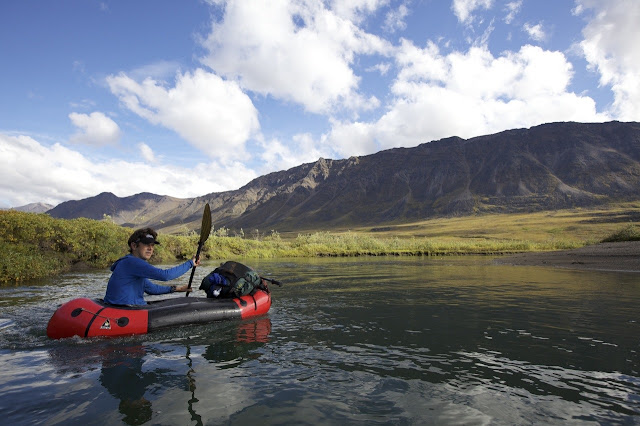
Paddling the oxbow bends on the Upper John.
Andrew Skurka and I left Anaktuvuk in sunshine.
Our goal, Circle Lake, lay four, maybe five days and 200 km away.
Our route: was classic. A packrafting traverse of the Gates of the Arctic National Park’s wild heart: walk 5 km out of Anaktuvuk, then inflate and paddle the John River 80 km to Wolverine Creek. Next walk 70 km up Wolverine, over upper Iniakuk, down upper Nahtuk, and into Pingaluk. Down Pingaluk to Alatna. Up Alatna to Circle Lake
It’s a variation on a route I’d done before, and one I’d do again, if I didn’t find myself in the fourth quarter of life.
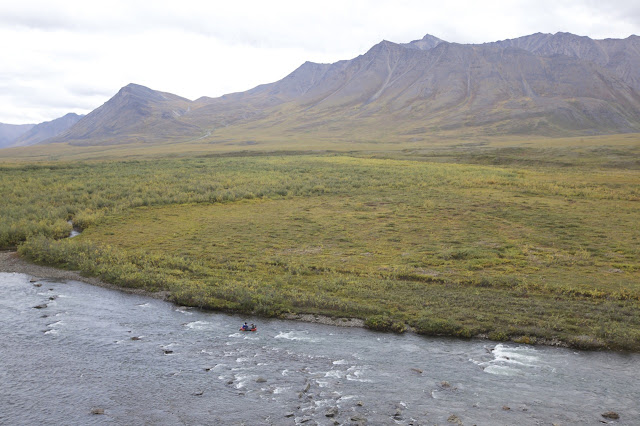
The first riffles on the upper John.
The Upper John
The John River starts out loopy and slow, meandering below barren mtns and tundra.
We enjoyed sufficient current to move but welcomed the acceleration as the river entered a shallow and splashy canyon. Unfortunately Talent’s raft was a bit too stripped down (for lightness), and took on water. The spray deck and narrower diameter tubes invited waves to warm themselves around Andy’s legs and loins.
With wind and rain and chilly water we ran most of the rapids conservatively, applying back-paddles and ferries to maneuver and avoid taking on water.
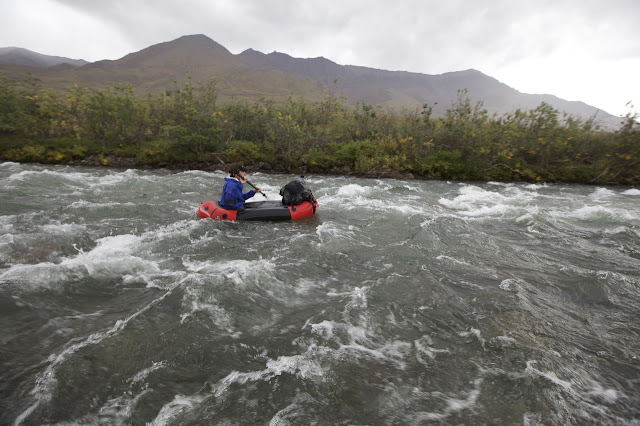
Looking for the dry line in a wet world – several kms of Class II.
Some say that the upper John has the most whitewater of the big four rivers (N. Fork Koyukuk, John, Alatna, and Noatak Rivers) in Gates of the Arctic National Park and having packrafted them all, I would agree.
It’s also the most inexpensive to run as you can fly in on a scheduled flight from Fairbanks and probably the most diverse of the four as well. Starting near the Eskimo village on the Arctic Divide, offering clean passage through a world of tussock hurt, it makes an exciting way down through willow, then cottonwood, and finally spruce.
For us that afternoon and evening we suffered a stiff wind blowing an Arctic drizzle, dressed only in rain gear.

First spruce on the John.
We pulled out after a series of class III- rapids below Till Creek, camping among willows.
Andy was very cold from the river and huddled in a brush pile making a fire. I set up the Cuben fiber mid (http://www.owareusa.com/ ), then stripped off my wet clothes and climbed into my dry ones.
I am too old to sleep in wet clothes.
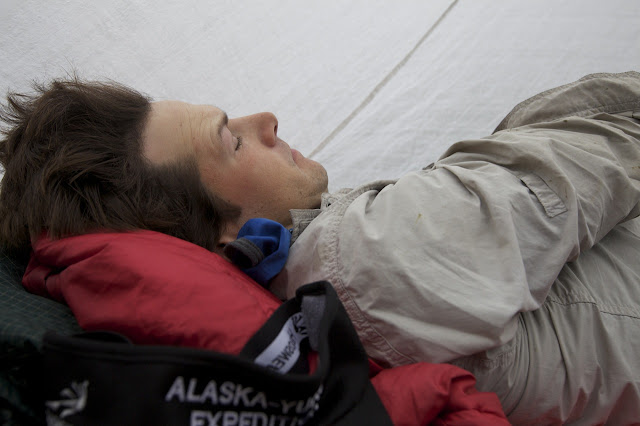
Hunkered down in an Arctic storm
The Middle John
By morning the river had risen a couple of feet and the rain continued. At least we were warm, dry, and happy getting into the boats.
It took us a while to get ready as we had only a wee, one-person cookpot. I’d sent my gallon-sized Arctic-style packrafting billy on ahead with the Photog. Unfortunately, it was a case of “liter-wise, gallon-silly”. A big pot doesn’t weigh so much more than a little one, especially it would speed up getting warm and hydrated when using a fire.
It was pretty clear that Andy had a very efficient style of camp, but it just didn’t include someone else. As for my style – I have come to depend on someone to take the other side of the mid and the other liter-and-a-half in the cook pot.
In fact, it’s hard for me to make friends unless we go somewhere and share.
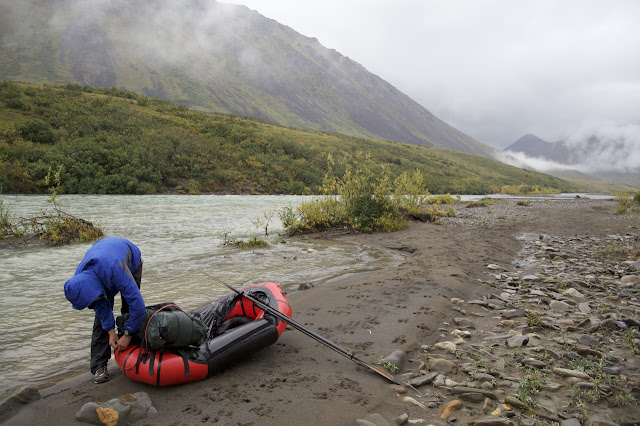 

Caribou tracks on the beach of a rising John River
The John had started as a stream and swelled to creek-size and then small river by the time we camped. But this morning it was a river and we made fast time and skirted big waves and Class III rapids.
The riverside yellows and hillside reds reminded us of the season, as if the rain and wind and icy water weren’t enough. I marveled at how skinny Skurka stayed warm as fat ole’ me in my three layers (wool hoody + capilene turtleneck + wool short-sleeve base) and his two (wool hoody + wool base).
Both welcomed an end to the rain, when we pulled over to make a big fire, stripping to our butts and waving naked at the planes flying low.
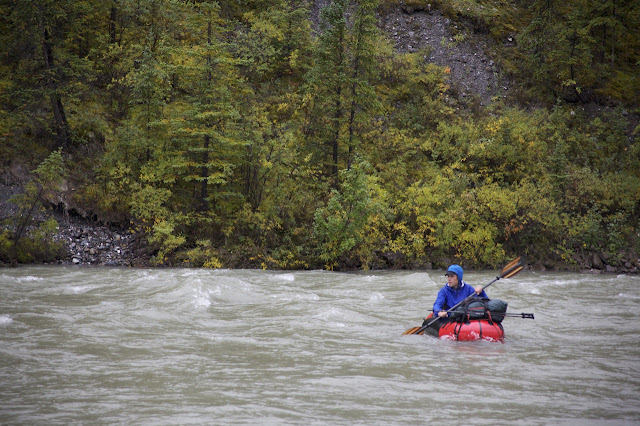

August 16
"First packrafting in 6 weeks on splashy Class3 John River. 25 miles in 6 hours. 30 more miles until take-out.”
Besides our camp style differences, we paddled quite differently as well. Andy paddled like the best student in the class whose text was Packrafting! (Buy it here: http://packrafting.blogspot.com/).
On the other hand I had been spoiled by too many seasons of big water and steep drops, waves and rapids and adrenaline with a snug spray deck, a dry suit, and thigh straps, although none of that was needed here on the John.
I remembered Skurka’s classic technique well. For it was on this river when I was 25 and Peggy 24 and pregnant that we crammed us both into a boat no bigger than the Alpacka Llama and floated this very river at very nearly this level in very near that style.
Except then we had garbage bags and coated nylon instead of drybags and Pertex. Still we slept in a mid, under a synthetic quilt and drank lots of warm fluids around burly fires of driftwood. That much was the same.
And so was the river.

Taking the dry line in a spooky world – a corner of Class III.
After the Hunt Fork fed the John the river grew really big and we screamed along. There were no sweepers and no rapids and the clouds broke and the sun came out and we talked about ecology and boreal forest and taiga.
Andy had many questions about landforms and animals and plant growth and the environment, thoughts I could tell that had been building.
For weeks, if not months, as he traversed wide-eyed and curious through raw landscapes and big wilderness -- feeling awe and love and fear and hate for a place that felt nothing for him -- he’d had no one to discuss the topics that his analytic mind produced.
Andy’s time with others came in towns and villages and cramped, stinky rides thumbed to a re-supply. Only rarely could he share his thoughts as they came to him and while we floated effortlessly and joyfully down a beautiful river, Andy shared his thoughts with me.
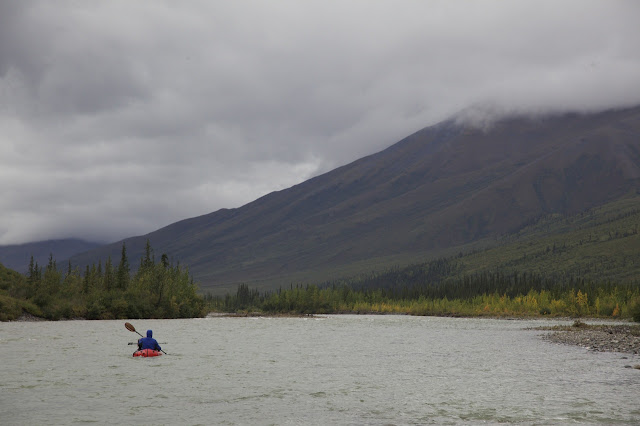
August 17
"Major ecological shift during 50mi John River float: Arctic brush-free tundra to boreal forest (spruce, alder, cottonwood, prickly rose)”
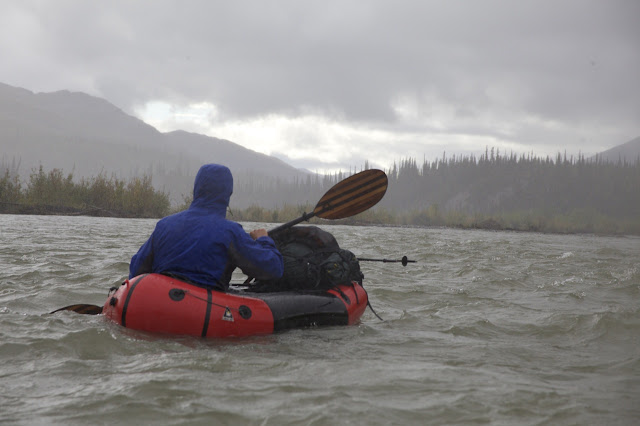
Small boat on big volume John River
The lower John is loopy and slow and maddeningly dull, with mountains fading to hills and hills to flats. Or so I have heard. I refuse to subject myself to that, thinking that when in the Brooks Range, keep to the mountains.
Just as Peggy and I did in 1986, Andy and I in 2010 stopped at Wolverine Creek to hike west toward the next big drainage, the Alatna.
That’s the classic way really: the pack follows the raft, the raft follows the pack, then repeat. Punctuate with fire, hot and cheery, telling stories and throwing down soupy meals you’ll call dinner, crawling closer as the night’s frost falls.
 

Dry feet
When Andy and I had first travelled together through the Wrangells, I sensed there might be some competition, or if not competition, then an effort to prove skill, strength and speed.
In fact, Michael was fearful of this display of raw performance (based on his earlier experience with Andrew in the Alaska Range) so while in Anchorage I stripped his pack of anything but the food I thought he’d need and the gear I knew he would.
“Michael,” I warned, “think of Andrew as a wild animal and be a wildlife photographer.”
So we’d flown into the Wrangells prepared to not just keep up with Andrew Skurka, professional hiker, but to stay ahead.
When we did, Skurka found it maddening.
When Andy was unable to keep up with Michael and me on the moraine above the Russell Glacier, he told us how his pack was heavier than ours, how the breakable crust of the week before had broken him, of how at Day 65 -- or whatever it was -- on all his mega-trips his legs feel leaden and he slows down.
As we stumbled and slid past the icebergs and mud of the Skolai Pass “Tar Pits”, he asked if I’d ever felt that way.
I told him that I had never made it to a day 65, so I wouldn’t really know. I did recount that I generally felt stronger the longer I’d been out, not weaker.
For instance, following a week-long X Games Adventure Race with a 7-week traverse of the Alaska Range prepared me to go directly to the BC Eco-Challenge Expedition Race and finish second. After the Eco I did feel pretty whipped (that would have been about day 63) but I had chalked it up to sleep deprivation over the course of a 500 km adventure race through the mountains of coastal British Columbia.
But as we walked over the frozen Skolai Lake and climbed upward to Chitistone Pass, a May blizzard scratching at our eyes, he revealed the truth: Day 65 or not, like the wilderness jock that he is, he postholed a trail through crotch-deep breakable-crust for hours.
I could barely keep up.
What I realized is that Andrew Skurka’s an endorphine user, but not an adrenaline junky. He’s hooked on a low-grade buzz that comes from months of moving, rather than the fear and reaction of a moment.
And good for him.
I passed Michael the tin of chewing tobacco.
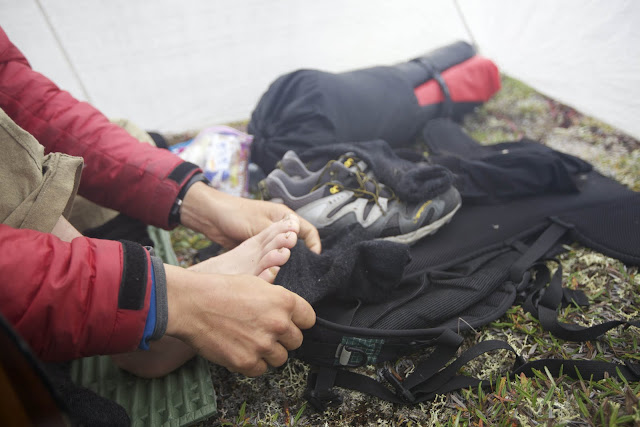
Wolverine Creek
August 17
" Roman Dial's farts stink but his book Packrafting! is great.” Sweet campsite: spruce, fire, & soft tundra bed.” --- Shoeing the racehorse
The going was too good to be true -- game trails and gravel bars and easy crossings – far better than my 25 year memory of Wolverine Creek.
Yet it wasn’t too good to be boring. We had to find the trails and hold them. We had to pick lines across the creek, and the bars were more like boulder-hopping than gravel-slogging or cobble-hobbling.
We flew up the valley, swinging leads, the way I like it.
When I was an ice and alpine climber, leading was it. The sharp end was the good end. It kept you frosty, alert, engaged. Even today, I prefer to lead and find the way, off-trail or downriver.
But the best partners swing leads. In wilderness travel it works this way: you lead till you lose the best route and your partner picks it up. Repeat.
Often, good trails run parallel and partners look for better routes and pull ahead, calling “Trail!” Then you drop in behind because their route’s faster ‘till it bogs down and they thrash and you look off to the side and now you’re moving there and you announce, “Trail!”.
Swinging leads.
“You know, I don’t think I’ve ever travelled with someone of your caliber. It’s really nice.”
“I was thinking the same thing.”
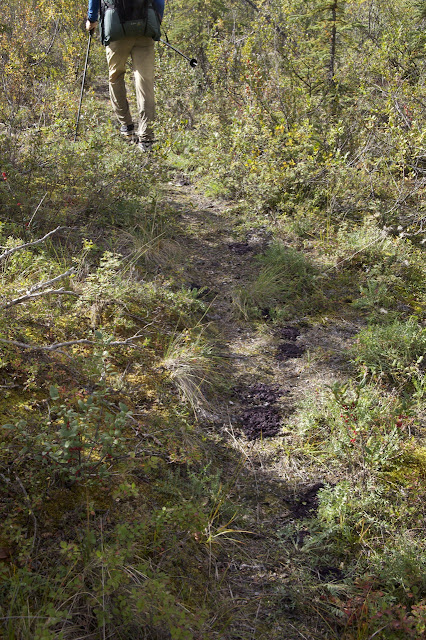
Five k/hr bear trail on Wolverine Creek
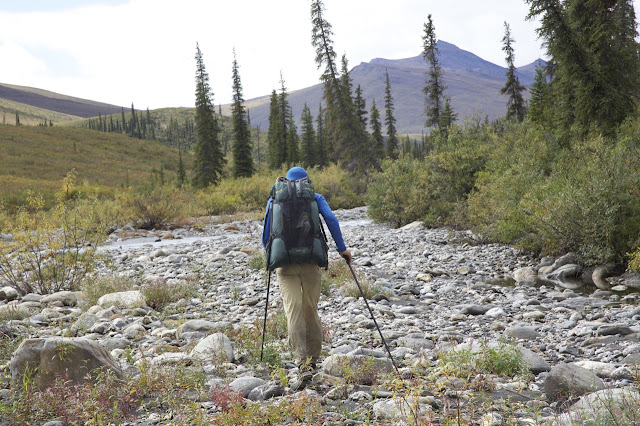
Cobbles, but not hobbles.
Dynamic speed, surprisingly, moves you along faster when holding game trails than slow, thoughtful deliberation. Seems counterintuitive, and I have tried to explain it, to understand it.
Andrew gets it and got it without me showing him.
It seems that good trail holding (trail finding is easy, it’s the holding that’s tricky) requires a three dimensional view for we humans, a way to see where the trail leads beneath overhanging shrubs. Moving allows perception to selectively determine distance and so focus and to pick out the seam to follow.
This is getting awful close to a backapackinglight.com statistical thesis. I’ll move on.
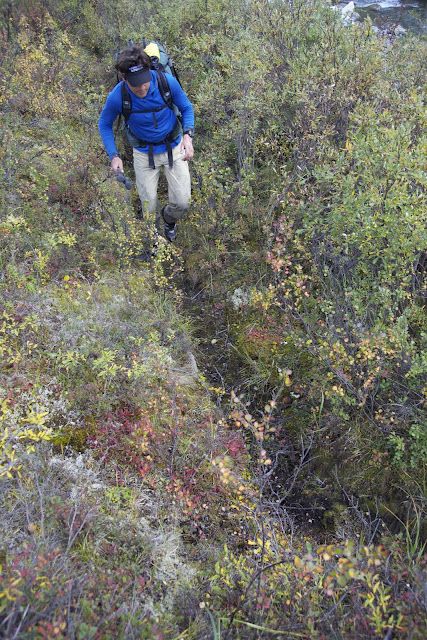
BMWs (Bear-Moose-Wolf) are fast and clean.
The going was good, too good, it seemed and we talked as we walked on bear trails in beautiful weather with no bugs.
We talked about books we wanted to write and gear and packrafting and people like Ryan Jordan and Barack Obama and James Balog.
We enjoyed good walking, terrain that rewards you for close attention, but offers non-stop jawing, as we moved up valley, cris-cross-recross-cross over the clear, boulder-pocked bed of Wolverine Creek, the best west-tending valley on the south side of the Brooks Range.
I knew where I wanted to get that night and so did Skurka. Difference was, he probably had known since January of the winter before.

Nap-time – how Skurking happens.
Parents and teachers and spouses and partners know that the best relationships provide complementarity learning. You may be teaching, but you’re learning, too.
Travelling with Andrew Skurka in your neighborhood is a lot like that. He’s learning from you, but you’re learning from him and he doesn’t act like he’s invented this stuff or that he’s the only one doing it.
There are other distance walkers in Alaska, both the inventors and the re-inventors, and I prefer the honesty of the former to the arrogance of the latter.
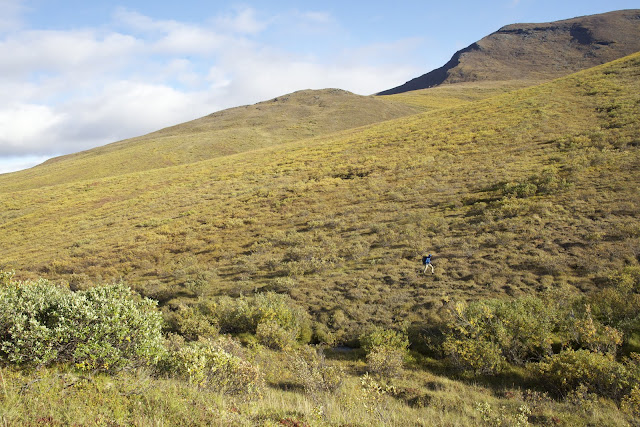

August 18
" Shockingly good travel up Wolverine Creek via game trails, bars, & woodland. Roman spoke wolf with locals near camp. Fall sunshine.”
One of my dreams is to establish multisport routes across Alaska, our own versions of the AT, PCT and Continental Divide Trail. These would be routes with packrafting, mtn biking, glacier skiing, sea kayaking and walking. The way would not be marked on the landscape but maybe carried as a sequence of GPS waypoints or, better yet, dots on a downloadable map.
It’s the dot connecting that makes wilderness travel (no “man-trails”), as opposed to say backcountry (maintained and mapped trails), so satisfying. The bigger the distance between the dots, the more satisfying.
I have several outlined already, routes that I have mostly done, not all in one go, like Skurka does, but pieced together. I have four of them (“Kaktovik to Kotzebue” across the Brooks Range, “Canada to Lake Clark” the length of the Alaska Range”, “Copper and Gold” from Nabesna to Juneau, and the “Big Southcentral Loop” 500 km loop around Anchorage) and it’s taken me thirty years to do them all.
Skurka did half of those in six months, a wild jock establishing the boundaries of the possible.
If I was thirty that would bug me. I’d find something that he didn’t do right. But I am fifty and honored to help him accomplish his own landscape art, even if my help was simply a few encouraging emails, a map exchange or two, talking to him on the sat phone during his times of need.
When I was 21 years old I met Dick Griffith, then 55, and fancied one day I might be like him. Three decades later I am no closer to Dick Griffith than I was when I met him. Nor will I ever be like him. But what I learned was to take an interest in those you admire who are younger and eager.
It’s not Dick’s accomplishments, or his ability to walk ,ski or packraft at an age when I’ll likely be too gimpy to get around. It’s his heart. His easy laugh, his ability to make people feel at ease, his ability to inspire. Dick is one of those people that make you feel better after you spend time with him. What Dick has are gifts, as well as skills.
But I think sharing is a skill, one I learned from Dick.
Nahtuk and Pingaluk

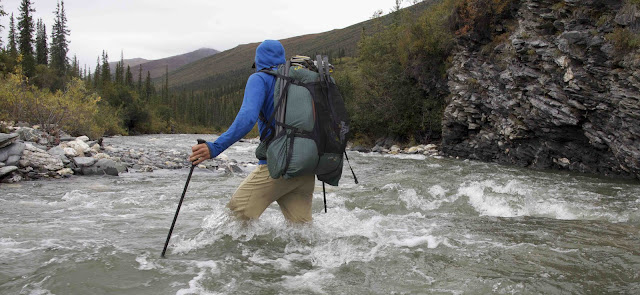
Upper Nahtuk: easy crossing, sporty boating
The Upper Nahtuk is a wonderful place, open and scenic, wild and fast. Exhilerating.
A wolf had followed us for an hour or so from the upper Iniakuk into the Nahtuk, we talking wolf-talk and he (or she) talking back. We pitched the mid and cooked over the cat food can recounting the day’s travel. Maybe the best day of walking for me all summer.
“The Eastern Brooks is all gray rock and dry barren mtns,” recounted Andy. “The Gates is much better and more varied. I really like this south side.”
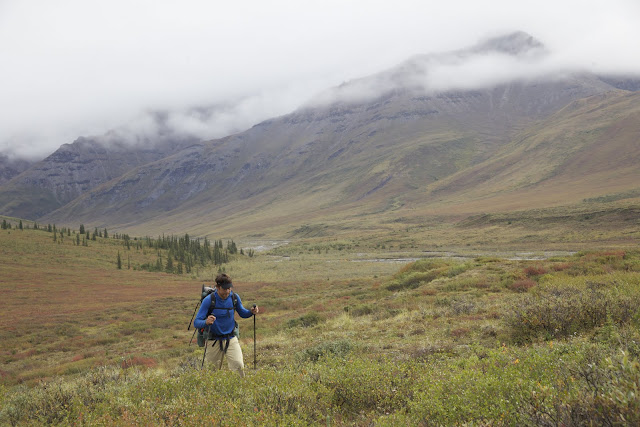 

Upper Nahtuk
But Wolverine-Iniakuk-Nahtuk-Pingaluk is unique among south side routes. Almost no tussocks, brush or hard-to-bypass canyons. In fact, out of the 100 km between the John and the Alatna, we had but 3 hours of bad travel, travel with “heads” (gallon-sized or larger tussocks), “f*ck-sticks” (any of a variety of bad bush or woods), and “stupid walking” (cliffed-out, in moving water to your knees).
Also, both upper Nahtuk and Pingaluk were packraftable at, say, Class III-, maybe a spot of III+. But the walking was so good that the world’s greatest hiker didn’t want to boat.
This wasn’t my trip. So we walked and talked and followed well-worn bear trails.
We even encountered a bear, a story told in pictures over at the Roaming Dials.


August 19
" Exciting bear encounter in upper Nahtuk River. Big grizzly ran at us to within
50ft then left reluctantly. Roman has photos.”
“That bear’s the first one I’ve seen in 4000 miles that didn’t run. Why didn’t it?”
I told him the story of pregnant Peggy and me with three shells in my 30-.06 and a bear charging us over an over. When I gave her the canyon and felt my body slip into animal mode to protect my woman and unborn child. That had taken place just an hour or two upstream almost 25 years ago. This was probably that bear’s descendent.
Andy’s analytic and a quick study.
“What made you decide to cut that corner?” he asked as we climbed and wove through sponga with resin birch grabbing our thighs flexing to gain elevation.
“So this is resin birch? I’ve been calling it willow,” as he fingered a small, oval leaf tinged red.
“What tricks do you use to get wet willow going?” as he struck magnesium and steel.
“Why not take a nap here?” he suggested, taking off his shoes and nestling himself in the tundra like a sofa.
“What causes tussocks to grow on hillsides?”
And “Why not just walk down the creek?”
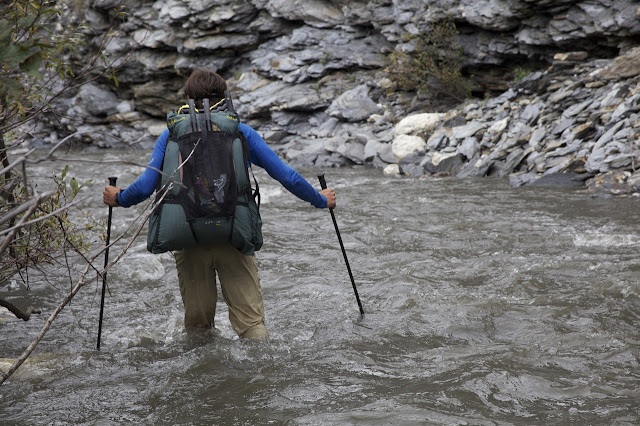
“Stupid walking” down the S fork of Pingaluk.
Foot entrapment. Trench foot. Falls. Swims. Cuts and bruises, even dislocations were the right answers, but all I could offer up was that it’s just bad style.
Good style is not having to walk down a running creek-bed, because you made good route choices before getting pinched-off or cliffed-out or fed-up with f*cksticks and “Owl-ders” (Andy’s funny E Coast and slightly annoying way of pronouncing “All-ders”).
Alders, a relative of the forest’s birch tree, the resin birch that slows your passage at timber-line, and the dwarf birch that wears out the fabric uppers of your shoes above, is mercifully sparse in the Brooks Range. It doesn’t like permafrost much but as the climate warms it’s spreading.
“What do you think about global warming? Isn’t it just a natural progression?”
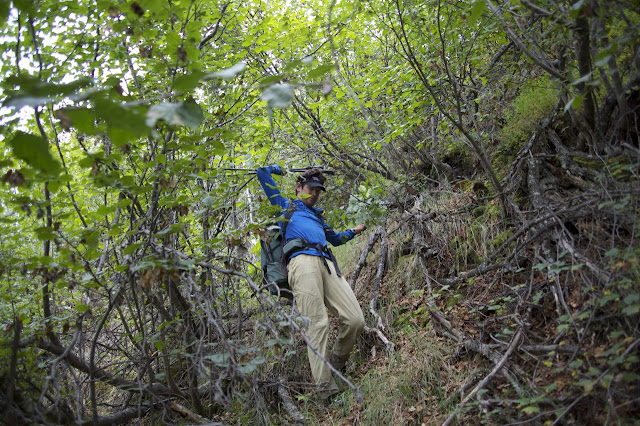
Natural progression though the Alders.
Oh to be in my twenties and thirties again. Time passed slower then. My muscles had sinew and speed. My eyes were still wide with the wonder of discovery and the challenge of the conventional.
As we age we lose that, especially after passing over the hill of 40. Then we have to parasitize youth who will tolerate us, hold tight to their coat-tails, peering over their shoulder to see what we once saw and felt, but through new eyes and bodies.
Our own kids are good for that, but others’ kids will do in a pinch.
And what do we have to offer? Encouragement? Acceptance? Advice?
I advised that we put in on the Pingaluk as soon as we came to its main fork. But the animal trails were just too good, just too world-class.
We napped in blueberry fields so heavy with fruit that the bushes lay down until you stripped them of their bounty and they stood tall again.
“Why don’t you use two trekking poles?”
“Where do you think that moose trail went?”
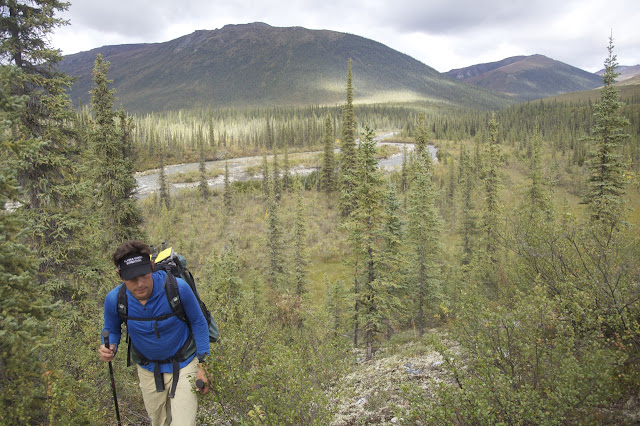
Bear trails with their deep-set post-holes in the moss and lichen led along the canyon rims, but moose trails climbed high above the alder thickets that closed in on side-drainages.
We’d find ourselves high and traversing, the Pingaluk pulling at my paddle with its boulder gardens and spire lined canyon walls.
But Andy wanted to walk. And it was Andy’s trip, his time to shine in the Brooks Range. So we walked until it was clear the moose trails took us down to meek water.
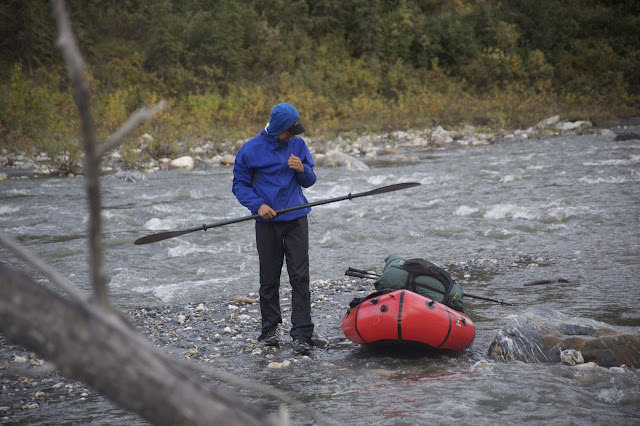

August 19
" Eleven hours of Brooks Range best: game trails, river bars, canyons, & packrafting. Three hours of worst: brushy hummocks & tussocks. Colorful foliage all day.”
After the Pingaluk was released from its schist-sharp canyons it braided out and thinned, sinking into its gravel bed.
We elbow-tubed and star-fished, scraping our butts on shallows and ducking sweepers.
My yellow Llama with its bigger volume tubes and larger foot-print floated these shallows better than Andy’s thin-tubed, custom craft in its handsome black and red.
Andy now has enough experience to design his own boat, something that’s not gram-wise and hour-silly. Meaning, weight and time are related in this activity we call “lightweight adventuring”, and sometimes what we do to minimize weight tends to increase time, “handling-time” in particular.
Experience shows that there is not just one axis to optimize, but two, or maybe even three: weight, time, satisfaction.
We were both happy to reach deeper flow as the Pingaluk aquifer met that of the Alatna. The night was dark and disorienting – well, dark as it can be in August in the Arctic.
The Alatna flowed mighty and firm, high from rain and melt at its headwaters and we ferried across its glassy, powerful current to eddy out on a sandy beach, yellow in limp horsetails, cottonwood suckers and willow seedlings.
Chilled by wet boats and the Arctic night, we made a big fire and recounted the day again.
Killing Time at Circle Lake

Circle Lake was only a few km upstream but it took far too long to get there. All the great travel was now forgotten, fighting alders thick in stem and growth. Tussocks and soggy lake edges sucked at our feet. Sharp dead branches clawed at my dry bag as I wrestled through spruce.
We had to make Circle Lake to meet Michael and get more food for the next leg. But the weather was choked up to the south and the pilots from Bettles wouldn’t fly.
So we were pinned down and low on food, bored but uncertain.
“More tea?” I tossed the powdered milk and brown sugar.
Andrew had become a coffee drinker during the Alaska Range segment with Forrest McCarthy. But stuck and waiting with coffee is more like grinding teeth than killing time.
Perched waiting on the mossy knoll above the lake, we read and wrote, drank tea and napped in between, while Andy texted his Mom and Michael.
It was good to see that he knew how to wait with patience, grace, and humor, as waiting, as much as moving, is a skill necessary for wilderness travel. One among many that Andy Skurka picked up after five months and 6000 km in the best wilderness left on Earth.
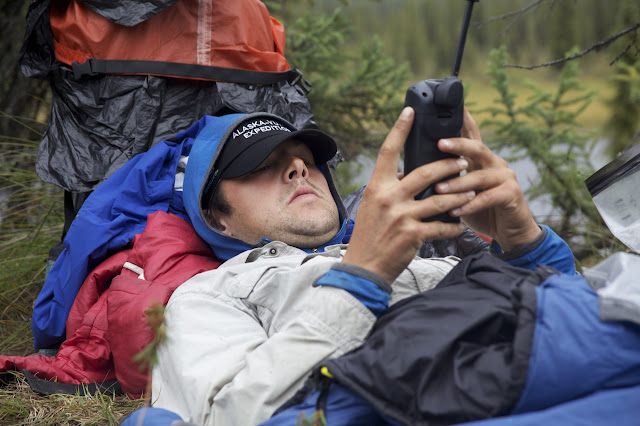

August 20
" Short day due to weather-related hang-up with NG photographer. Stuck in Alatna valley until his flight can arrive. Low on food.”
Packrafter extraordinaire. Roman is in a League of his own - he wrote the de-facto book on it


August 15
Mi 4209 Anaktuvuk Pass. Overnight stop an opportunity to do laundry,
shave, call parents. Package pickup in AM, then 12-day push to Ambler.”
We were a Party Train on an errand, a rather long errand, at the tail end of an Epic:
The Talent, the Photographer, the Hack and the Lackey pulled up short in Anaktuvuk Pass, a Nunamiut village of Innupiaq in the Brooks Range.
Three days walk from the nearest highway and the Alaska Pipeline, we found ourselves wandering dusty roads with ATVs buzzing thick as mosquitoes on tundra. The village was mourning.
A thirty year old father of eight had died water skipping his snow machine on a nearby lake. Unable to swim, and maybe drinking, he’d drowned in waist deep water on a sunny day.
We were happy campers in an unhappy village. Crowded by kids at the post office, a pretty little girl of four told us bluntly, “My Dad died.”
The Hack would fly out momentarily -- he had his story.
The Photog, never satisfied with his pictures, needed to replace hard drives and memory cards and would leave the next day.
That left me, the Lackey, with a borrowed camera in hand, to chase the Talent in case something cool happened.
Lots of cool things happened and these are some of the best.


Paddling the oxbow bends on the Upper John.
Andrew Skurka and I left Anaktuvuk in sunshine.
Our goal, Circle Lake, lay four, maybe five days and 200 km away.
Our route: was classic. A packrafting traverse of the Gates of the Arctic National Park’s wild heart: walk 5 km out of Anaktuvuk, then inflate and paddle the John River 80 km to Wolverine Creek. Next walk 70 km up Wolverine, over upper Iniakuk, down upper Nahtuk, and into Pingaluk. Down Pingaluk to Alatna. Up Alatna to Circle Lake
It’s a variation on a route I’d done before, and one I’d do again, if I didn’t find myself in the fourth quarter of life.


The first riffles on the upper John.
The Upper John
The John River starts out loopy and slow, meandering below barren mtns and tundra.
We enjoyed sufficient current to move but welcomed the acceleration as the river entered a shallow and splashy canyon. Unfortunately Talent’s raft was a bit too stripped down (for lightness), and took on water. The spray deck and narrower diameter tubes invited waves to warm themselves around Andy’s legs and loins.
With wind and rain and chilly water we ran most of the rapids conservatively, applying back-paddles and ferries to maneuver and avoid taking on water.


Looking for the dry line in a wet world – several kms of Class II.
Some say that the upper John has the most whitewater of the big four rivers (N. Fork Koyukuk, John, Alatna, and Noatak Rivers) in Gates of the Arctic National Park and having packrafted them all, I would agree.
It’s also the most inexpensive to run as you can fly in on a scheduled flight from Fairbanks and probably the most diverse of the four as well. Starting near the Eskimo village on the Arctic Divide, offering clean passage through a world of tussock hurt, it makes an exciting way down through willow, then cottonwood, and finally spruce.
For us that afternoon and evening we suffered a stiff wind blowing an Arctic drizzle, dressed only in rain gear.


First spruce on the John.
We pulled out after a series of class III- rapids below Till Creek, camping among willows.
Andy was very cold from the river and huddled in a brush pile making a fire. I set up the Cuben fiber mid (http://www.owareusa.com/ ), then stripped off my wet clothes and climbed into my dry ones.
I am too old to sleep in wet clothes.

Hunkered down in an Arctic storm
The Middle John
By morning the river had risen a couple of feet and the rain continued. At least we were warm, dry, and happy getting into the boats.
It took us a while to get ready as we had only a wee, one-person cookpot. I’d sent my gallon-sized Arctic-style packrafting billy on ahead with the Photog. Unfortunately, it was a case of “liter-wise, gallon-silly”. A big pot doesn’t weigh so much more than a little one, especially it would speed up getting warm and hydrated when using a fire.
It was pretty clear that Andy had a very efficient style of camp, but it just didn’t include someone else. As for my style – I have come to depend on someone to take the other side of the mid and the other liter-and-a-half in the cook pot.
In fact, it’s hard for me to make friends unless we go somewhere and share.
 
Caribou tracks on the beach of a rising John River
The John had started as a stream and swelled to creek-size and then small river by the time we camped. But this morning it was a river and we made fast time and skirted big waves and Class III rapids.
The riverside yellows and hillside reds reminded us of the season, as if the rain and wind and icy water weren’t enough. I marveled at how skinny Skurka stayed warm as fat ole’ me in my three layers (wool hoody + capilene turtleneck + wool short-sleeve base) and his two (wool hoody + wool base).
Both welcomed an end to the rain, when we pulled over to make a big fire, stripping to our butts and waving naked at the planes flying low.


August 16
"First packrafting in 6 weeks on splashy Class3 John River. 25 miles in 6 hours. 30 more miles until take-out.”
Besides our camp style differences, we paddled quite differently as well. Andy paddled like the best student in the class whose text was Packrafting! (Buy it here: http://packrafting.blogspot.com/).
On the other hand I had been spoiled by too many seasons of big water and steep drops, waves and rapids and adrenaline with a snug spray deck, a dry suit, and thigh straps, although none of that was needed here on the John.
I remembered Skurka’s classic technique well. For it was on this river when I was 25 and Peggy 24 and pregnant that we crammed us both into a boat no bigger than the Alpacka Llama and floated this very river at very nearly this level in very near that style.
Except then we had garbage bags and coated nylon instead of drybags and Pertex. Still we slept in a mid, under a synthetic quilt and drank lots of warm fluids around burly fires of driftwood. That much was the same.
And so was the river.


Taking the dry line in a spooky world – a corner of Class III.
After the Hunt Fork fed the John the river grew really big and we screamed along. There were no sweepers and no rapids and the clouds broke and the sun came out and we talked about ecology and boreal forest and taiga.
Andy had many questions about landforms and animals and plant growth and the environment, thoughts I could tell that had been building.
For weeks, if not months, as he traversed wide-eyed and curious through raw landscapes and big wilderness -- feeling awe and love and fear and hate for a place that felt nothing for him -- he’d had no one to discuss the topics that his analytic mind produced.
Andy’s time with others came in towns and villages and cramped, stinky rides thumbed to a re-supply. Only rarely could he share his thoughts as they came to him and while we floated effortlessly and joyfully down a beautiful river, Andy shared his thoughts with me.

August 17
"Major ecological shift during 50mi John River float: Arctic brush-free tundra to boreal forest (spruce, alder, cottonwood, prickly rose)”


Small boat on big volume John River
The lower John is loopy and slow and maddeningly dull, with mountains fading to hills and hills to flats. Or so I have heard. I refuse to subject myself to that, thinking that when in the Brooks Range, keep to the mountains.
Just as Peggy and I did in 1986, Andy and I in 2010 stopped at Wolverine Creek to hike west toward the next big drainage, the Alatna.
That’s the classic way really: the pack follows the raft, the raft follows the pack, then repeat. Punctuate with fire, hot and cheery, telling stories and throwing down soupy meals you’ll call dinner, crawling closer as the night’s frost falls.
 
Dry feet
When Andy and I had first travelled together through the Wrangells, I sensed there might be some competition, or if not competition, then an effort to prove skill, strength and speed.
In fact, Michael was fearful of this display of raw performance (based on his earlier experience with Andrew in the Alaska Range) so while in Anchorage I stripped his pack of anything but the food I thought he’d need and the gear I knew he would.
“Michael,” I warned, “think of Andrew as a wild animal and be a wildlife photographer.”
So we’d flown into the Wrangells prepared to not just keep up with Andrew Skurka, professional hiker, but to stay ahead.
When we did, Skurka found it maddening.
When Andy was unable to keep up with Michael and me on the moraine above the Russell Glacier, he told us how his pack was heavier than ours, how the breakable crust of the week before had broken him, of how at Day 65 -- or whatever it was -- on all his mega-trips his legs feel leaden and he slows down.
As we stumbled and slid past the icebergs and mud of the Skolai Pass “Tar Pits”, he asked if I’d ever felt that way.
I told him that I had never made it to a day 65, so I wouldn’t really know. I did recount that I generally felt stronger the longer I’d been out, not weaker.
For instance, following a week-long X Games Adventure Race with a 7-week traverse of the Alaska Range prepared me to go directly to the BC Eco-Challenge Expedition Race and finish second. After the Eco I did feel pretty whipped (that would have been about day 63) but I had chalked it up to sleep deprivation over the course of a 500 km adventure race through the mountains of coastal British Columbia.
But as we walked over the frozen Skolai Lake and climbed upward to Chitistone Pass, a May blizzard scratching at our eyes, he revealed the truth: Day 65 or not, like the wilderness jock that he is, he postholed a trail through crotch-deep breakable-crust for hours.
I could barely keep up.
What I realized is that Andrew Skurka’s an endorphine user, but not an adrenaline junky. He’s hooked on a low-grade buzz that comes from months of moving, rather than the fear and reaction of a moment.
And good for him.
I passed Michael the tin of chewing tobacco.

Wolverine Creek
August 17
" Roman Dial's farts stink but his book Packrafting! is great.” Sweet campsite: spruce, fire, & soft tundra bed.” --- Shoeing the racehorse
The going was too good to be true -- game trails and gravel bars and easy crossings – far better than my 25 year memory of Wolverine Creek.
Yet it wasn’t too good to be boring. We had to find the trails and hold them. We had to pick lines across the creek, and the bars were more like boulder-hopping than gravel-slogging or cobble-hobbling.
We flew up the valley, swinging leads, the way I like it.
When I was an ice and alpine climber, leading was it. The sharp end was the good end. It kept you frosty, alert, engaged. Even today, I prefer to lead and find the way, off-trail or downriver.
But the best partners swing leads. In wilderness travel it works this way: you lead till you lose the best route and your partner picks it up. Repeat.
Often, good trails run parallel and partners look for better routes and pull ahead, calling “Trail!” Then you drop in behind because their route’s faster ‘till it bogs down and they thrash and you look off to the side and now you’re moving there and you announce, “Trail!”.
Swinging leads.
“You know, I don’t think I’ve ever travelled with someone of your caliber. It’s really nice.”
“I was thinking the same thing.”


Five k/hr bear trail on Wolverine Creek


Cobbles, but not hobbles.
Dynamic speed, surprisingly, moves you along faster when holding game trails than slow, thoughtful deliberation. Seems counterintuitive, and I have tried to explain it, to understand it.
Andrew gets it and got it without me showing him.
It seems that good trail holding (trail finding is easy, it’s the holding that’s tricky) requires a three dimensional view for we humans, a way to see where the trail leads beneath overhanging shrubs. Moving allows perception to selectively determine distance and so focus and to pick out the seam to follow.
This is getting awful close to a backapackinglight.com statistical thesis. I’ll move on.

BMWs (Bear-Moose-Wolf) are fast and clean.
The going was good, too good, it seemed and we talked as we walked on bear trails in beautiful weather with no bugs.
We talked about books we wanted to write and gear and packrafting and people like Ryan Jordan and Barack Obama and James Balog.
We enjoyed good walking, terrain that rewards you for close attention, but offers non-stop jawing, as we moved up valley, cris-cross-recross-cross over the clear, boulder-pocked bed of Wolverine Creek, the best west-tending valley on the south side of the Brooks Range.
I knew where I wanted to get that night and so did Skurka. Difference was, he probably had known since January of the winter before.


Nap-time – how Skurking happens.
Parents and teachers and spouses and partners know that the best relationships provide complementarity learning. You may be teaching, but you’re learning, too.
Travelling with Andrew Skurka in your neighborhood is a lot like that. He’s learning from you, but you’re learning from him and he doesn’t act like he’s invented this stuff or that he’s the only one doing it.
There are other distance walkers in Alaska, both the inventors and the re-inventors, and I prefer the honesty of the former to the arrogance of the latter.


August 18
" Shockingly good travel up Wolverine Creek via game trails, bars, & woodland. Roman spoke wolf with locals near camp. Fall sunshine.”
One of my dreams is to establish multisport routes across Alaska, our own versions of the AT, PCT and Continental Divide Trail. These would be routes with packrafting, mtn biking, glacier skiing, sea kayaking and walking. The way would not be marked on the landscape but maybe carried as a sequence of GPS waypoints or, better yet, dots on a downloadable map.
It’s the dot connecting that makes wilderness travel (no “man-trails”), as opposed to say backcountry (maintained and mapped trails), so satisfying. The bigger the distance between the dots, the more satisfying.
I have several outlined already, routes that I have mostly done, not all in one go, like Skurka does, but pieced together. I have four of them (“Kaktovik to Kotzebue” across the Brooks Range, “Canada to Lake Clark” the length of the Alaska Range”, “Copper and Gold” from Nabesna to Juneau, and the “Big Southcentral Loop” 500 km loop around Anchorage) and it’s taken me thirty years to do them all.
Skurka did half of those in six months, a wild jock establishing the boundaries of the possible.
If I was thirty that would bug me. I’d find something that he didn’t do right. But I am fifty and honored to help him accomplish his own landscape art, even if my help was simply a few encouraging emails, a map exchange or two, talking to him on the sat phone during his times of need.
When I was 21 years old I met Dick Griffith, then 55, and fancied one day I might be like him. Three decades later I am no closer to Dick Griffith than I was when I met him. Nor will I ever be like him. But what I learned was to take an interest in those you admire who are younger and eager.
It’s not Dick’s accomplishments, or his ability to walk ,ski or packraft at an age when I’ll likely be too gimpy to get around. It’s his heart. His easy laugh, his ability to make people feel at ease, his ability to inspire. Dick is one of those people that make you feel better after you spend time with him. What Dick has are gifts, as well as skills.
But I think sharing is a skill, one I learned from Dick.
Nahtuk and Pingaluk


Upper Nahtuk: easy crossing, sporty boating
The Upper Nahtuk is a wonderful place, open and scenic, wild and fast. Exhilerating.
A wolf had followed us for an hour or so from the upper Iniakuk into the Nahtuk, we talking wolf-talk and he (or she) talking back. We pitched the mid and cooked over the cat food can recounting the day’s travel. Maybe the best day of walking for me all summer.
“The Eastern Brooks is all gray rock and dry barren mtns,” recounted Andy. “The Gates is much better and more varied. I really like this south side.”
 
Upper Nahtuk
But Wolverine-Iniakuk-Nahtuk-Pingaluk is unique among south side routes. Almost no tussocks, brush or hard-to-bypass canyons. In fact, out of the 100 km between the John and the Alatna, we had but 3 hours of bad travel, travel with “heads” (gallon-sized or larger tussocks), “f*ck-sticks” (any of a variety of bad bush or woods), and “stupid walking” (cliffed-out, in moving water to your knees).
Also, both upper Nahtuk and Pingaluk were packraftable at, say, Class III-, maybe a spot of III+. But the walking was so good that the world’s greatest hiker didn’t want to boat.
This wasn’t my trip. So we walked and talked and followed well-worn bear trails.
We even encountered a bear, a story told in pictures over at the Roaming Dials.


August 19
" Exciting bear encounter in upper Nahtuk River. Big grizzly ran at us to within
50ft then left reluctantly. Roman has photos.”
“That bear’s the first one I’ve seen in 4000 miles that didn’t run. Why didn’t it?”
I told him the story of pregnant Peggy and me with three shells in my 30-.06 and a bear charging us over an over. When I gave her the canyon and felt my body slip into animal mode to protect my woman and unborn child. That had taken place just an hour or two upstream almost 25 years ago. This was probably that bear’s descendent.
Andy’s analytic and a quick study.
“What made you decide to cut that corner?” he asked as we climbed and wove through sponga with resin birch grabbing our thighs flexing to gain elevation.
“So this is resin birch? I’ve been calling it willow,” as he fingered a small, oval leaf tinged red.
“What tricks do you use to get wet willow going?” as he struck magnesium and steel.
“Why not take a nap here?” he suggested, taking off his shoes and nestling himself in the tundra like a sofa.
“What causes tussocks to grow on hillsides?”
And “Why not just walk down the creek?”


“Stupid walking” down the S fork of Pingaluk.
Foot entrapment. Trench foot. Falls. Swims. Cuts and bruises, even dislocations were the right answers, but all I could offer up was that it’s just bad style.
Good style is not having to walk down a running creek-bed, because you made good route choices before getting pinched-off or cliffed-out or fed-up with f*cksticks and “Owl-ders” (Andy’s funny E Coast and slightly annoying way of pronouncing “All-ders”).
Alders, a relative of the forest’s birch tree, the resin birch that slows your passage at timber-line, and the dwarf birch that wears out the fabric uppers of your shoes above, is mercifully sparse in the Brooks Range. It doesn’t like permafrost much but as the climate warms it’s spreading.
“What do you think about global warming? Isn’t it just a natural progression?”


Natural progression though the Alders.
Oh to be in my twenties and thirties again. Time passed slower then. My muscles had sinew and speed. My eyes were still wide with the wonder of discovery and the challenge of the conventional.
As we age we lose that, especially after passing over the hill of 40. Then we have to parasitize youth who will tolerate us, hold tight to their coat-tails, peering over their shoulder to see what we once saw and felt, but through new eyes and bodies.
Our own kids are good for that, but others’ kids will do in a pinch.
And what do we have to offer? Encouragement? Acceptance? Advice?
I advised that we put in on the Pingaluk as soon as we came to its main fork. But the animal trails were just too good, just too world-class.
We napped in blueberry fields so heavy with fruit that the bushes lay down until you stripped them of their bounty and they stood tall again.
“Why don’t you use two trekking poles?”
“Where do you think that moose trail went?”


Bear trails with their deep-set post-holes in the moss and lichen led along the canyon rims, but moose trails climbed high above the alder thickets that closed in on side-drainages.
We’d find ourselves high and traversing, the Pingaluk pulling at my paddle with its boulder gardens and spire lined canyon walls.
But Andy wanted to walk. And it was Andy’s trip, his time to shine in the Brooks Range. So we walked until it was clear the moose trails took us down to meek water.


August 19
" Eleven hours of Brooks Range best: game trails, river bars, canyons, & packrafting. Three hours of worst: brushy hummocks & tussocks. Colorful foliage all day.”
After the Pingaluk was released from its schist-sharp canyons it braided out and thinned, sinking into its gravel bed.
We elbow-tubed and star-fished, scraping our butts on shallows and ducking sweepers.
My yellow Llama with its bigger volume tubes and larger foot-print floated these shallows better than Andy’s thin-tubed, custom craft in its handsome black and red.
Andy now has enough experience to design his own boat, something that’s not gram-wise and hour-silly. Meaning, weight and time are related in this activity we call “lightweight adventuring”, and sometimes what we do to minimize weight tends to increase time, “handling-time” in particular.
Experience shows that there is not just one axis to optimize, but two, or maybe even three: weight, time, satisfaction.
We were both happy to reach deeper flow as the Pingaluk aquifer met that of the Alatna. The night was dark and disorienting – well, dark as it can be in August in the Arctic.
The Alatna flowed mighty and firm, high from rain and melt at its headwaters and we ferried across its glassy, powerful current to eddy out on a sandy beach, yellow in limp horsetails, cottonwood suckers and willow seedlings.
Chilled by wet boats and the Arctic night, we made a big fire and recounted the day again.
Killing Time at Circle Lake


Circle Lake was only a few km upstream but it took far too long to get there. All the great travel was now forgotten, fighting alders thick in stem and growth. Tussocks and soggy lake edges sucked at our feet. Sharp dead branches clawed at my dry bag as I wrestled through spruce.
We had to make Circle Lake to meet Michael and get more food for the next leg. But the weather was choked up to the south and the pilots from Bettles wouldn’t fly.
So we were pinned down and low on food, bored but uncertain.
“More tea?” I tossed the powdered milk and brown sugar.
Andrew had become a coffee drinker during the Alaska Range segment with Forrest McCarthy. But stuck and waiting with coffee is more like grinding teeth than killing time.
Perched waiting on the mossy knoll above the lake, we read and wrote, drank tea and napped in between, while Andy texted his Mom and Michael.
It was good to see that he knew how to wait with patience, grace, and humor, as waiting, as much as moving, is a skill necessary for wilderness travel. One among many that Andy Skurka picked up after five months and 6000 km in the best wilderness left on Earth.


August 20
" Short day due to weather-related hang-up with NG photographer. Stuck in Alatna valley until his flight can arrive. Low on food.”